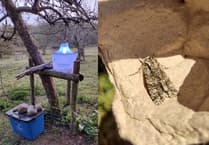This week, the government has announced plans to strengthen the ban on burning vegetation on upland peatland, known locally as swaling. The new law is expected to protect an additional 150,000 hectares of England’s peatland and closes some of the previous loopholes – the ban now applies to any peat deeper than 30cm whether or not in a conservation area.
Peat of 30cm or deeper in upland landscapes is called blanket bog. It forms when sphagnum mosses and other plants die and accumulate in waterlogged conditions. If in good condition, blanket bogs continue to accumulate carbon indefinitely and they retain large volumes of water, providing natural flood prevention. Their wet state also makes them more resilient to wildfires.
Deliberate or accidental burning of vegetation on our moorlands releases harmful smoke into the air, impacting air quality across the country. The government believes that the stronger ban on burning will reduce air pollutants that are harmful to human health causing strokes, cardiovascular disease, asthma and some lung cancers.
Healthy peat is this country’s biggest carbon store – an estimated 3.2 billion tonnes. That is more than all the forests of Britain, France and Germany according to the Office for National Statistics.
Burning vegetation on peatland to provide better grazing for livestock, dries out the peat, causing it to erode away and release its carbon. The eroded peat is blown away by wind or washed away into water courses, which is why the rivers flowing down from Exmoor, Dartmoor and Bodmin moor are stained brown.
Research by the University of Exeter has found that “just 1% of Dartmoor’s peatland area is still healthy peat-forming bog, whilst lots of the remainder has been severely damaged by drainage, cutting, drying and erosion.”
The South West Peatland Partnership is working to stop the erosion of 2,600 hectares of degraded peatland on Dartmoor, Exmoor and Bodmin Moor. By blocking the drainage channels and erosion gullies, the restoration work raises the water table and slows the release of water. As the ground becomes saturated, sphagnum moss can form, and the peatbog can lay down peat again. This also restricts the growth of a coarse grass called purple moor grass or Molinia which dominates degraded moorland.
Researchers at Plymouth University have been observing the changes in restored areas and have measured a significant shift away from purple moor grass monocultures to more varied vegetation within a decade. This is better for the wildlife that lives on upland moors and peat bogs, particularly amphibians and insects such as dragonflies, and ground-nesting birds like curlew and dunlin.
Healthy peatland also has multiple benefits for people – it alleviates flooding, stores water and improves water quality, and it is more resilient to wildfire. And an end to burning brings better air quality, greatly benefitting human health.
As a final thought, if you are buying compost for your own garden this spring, please make sure it is peat-free.




